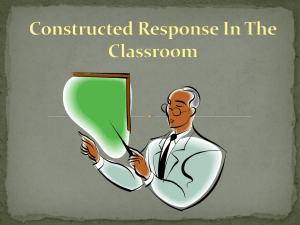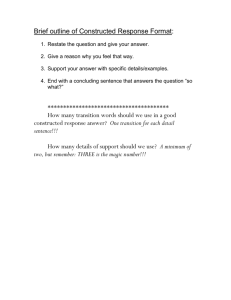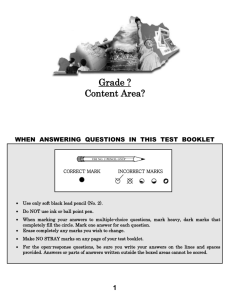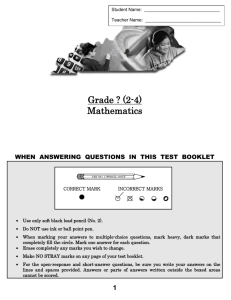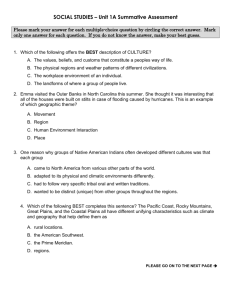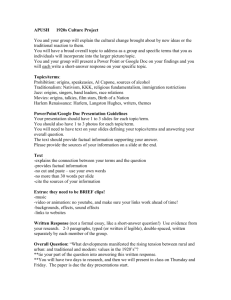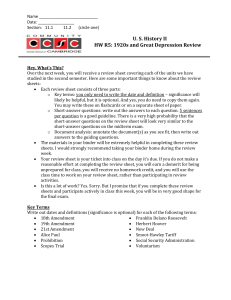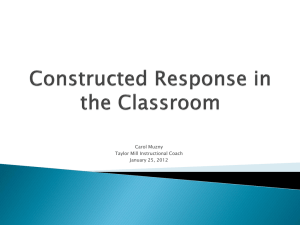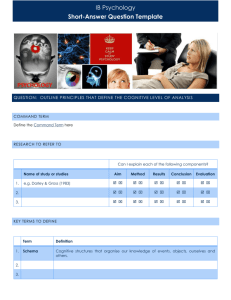Constructed Response in the Classroom Training Tool
advertisement
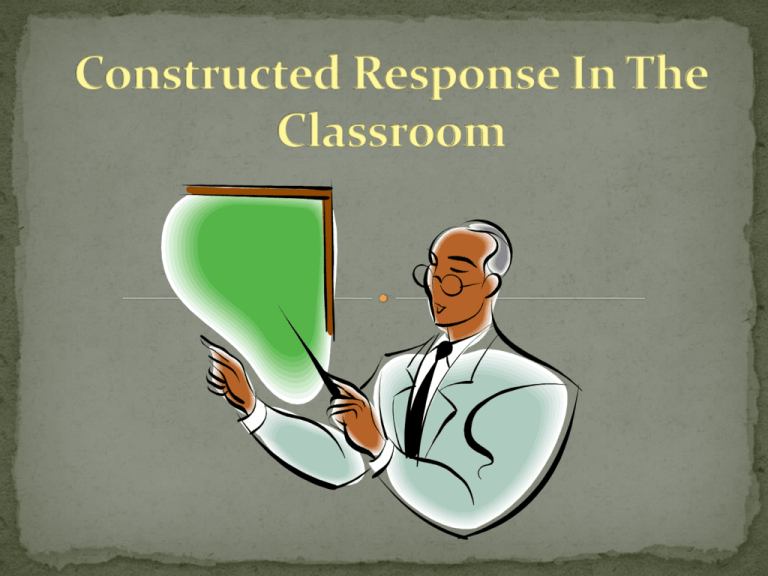
Become familiar with constructed response in the law Understand the meaning of constructed response Review open-response questions Know when to assess using short-answer or open- response questions Practice writing short-answer questions for a Kentucky core Academic Standard Identify strategies to help students respond to shortanswer and open-response questions In 2009, Kentucky legislators passed Senate Bill 1, which brought many changes to education. One of those changes was to overhaul the state assessment system, including the types of questions to be used to assess students. Beginning with the 2011-2012 school year, constructed response questions will be part of the state assessment. KRS 158.6453 (1) (b) "Constructed response or performance based items" means individual test items that require the student to create an answer rather than select a response and may include fill-in the blank, short-answer, extended answer, open-response, and writing on demand formats; (5) The state student assessments to be implemented in the 2011-2012 academic year shall include the following components: (d) The criterion-referenced components required in this subsection shall be composed of constructed response items and multiple choice items and the national norm-referenced components shall be composed of multiple choice items; Constructed-response questions are assessment items that ask students to apply knowledge, skills, and critical thinking abilities to real-world, standards-driven performance tasks. Constructedresponse questions are so named because there is often more than one way to correctly answer the question, and they require students to “construct” or develop their own answers without the benefit of any suggestions or choices. (Tests That Teach by Karen Tankersly) Constructed response questions include extended-response*, open-response, fill in the blank, and short answer. Here are some characteristics of constructed response questions. Constructed response prompts: Can use authentic, real-world situations or stimuli. Can include maps, charts, graphs, timelines, reading passages, etc. Constructed response questions can assess: Content knowledge. Application-level skills. One broad standard. Several specific standards. Constructed response answers: Are based on knowledge. Can be simple, requiring students to fill in the blank or answer in one or two sentences. Can be complex, requiring students to answer in multiple paragraphs, create graphs, charts, or maps by processing information, or develop a solution for a problem. Can require high-level thinking by having students analyze, synthesize, or evaluate information. If complex, are scored using a rubric, allowing for no credit, partial credit, or full credit for answering the question. The rubric should include examples to allow for scoring consistency. *Extended constructed-response questions are lengthier and more complex exercises that allow for a finer level of discrimination in scoring the responses. Kentucky’s new assessment will include constructed response questions, not open-response questions. Myth—Kentucky’s new assessment will include constructed response questions, which includes open-response. Rubrics are used to score some constructed response answers. True Sometimes constructed-response questions offer students suggestions for answers. Myth—Constructed response questions do not offer suggested answers. Constructed response questions only assess broad standards. Myth—Can assess a broad standard or specific standards. Constructed response questions can be simple or complex. True There are three overall types of writing and every school’s instructional program should include each: Writing to learn Writing to demonstrate learning or communicate knowledge (open-response is this type) Writing for Publication OPEN-RESPONSE Assesses a student’s ability to apply concepts and/or processes in a new situation based on the state standards learned. Contains a focus statement, scenario, or lead-in. Includes at least one content-related task using higher-level verbs. (The verbs should come from the higher levels on Bloom’s Taxonomy: Application, Analysis, Synthesis, and/or Evaluation.) Allows for at least two possible answers or different ways to show the work for the answer or solve the problem. Assesses higher-level use of content/concepts, but does NOT assess the student’s use of grammar or mechanics or writing style. Answers may include bullets, lists, diagrams, etc. and whatever else is helpful in communicating knowledge. These are all acceptable responses to open-response questions. Can be completed in 15-20 minutes using one page. Is scored using a teacher-designed scoring guide. 1. Scaffolded 2. Single Dimension/Component 3. Two or More Relatively Independent Components 4. Student Choice: Topics/Options Provided 5. Response to Provided Information Sequence of tasks increasingly more difficult/complex Success on one part would likely mean there was success on all previous parts Multipart (simple to complex) Straight-forward question Draw a conclusion or take a position, then support it with explanation, examples, evidence Explain a phenomenon or describe procedures Fairly independent questions addressing the same content Contains multiple parts (A,B,C,etc.) Choose from the provided options Response to provided information such as data, graphics, or informational reading The students in Mrs. Spalding’s class are planning a fall party. There are 29 students in the class. They have decided to have lemonade, orange soda, and colas to drink. They will give the first person lemonade, the second orange soda, and the next two students will receive a cola each. This pattern continues. A. Create a table to show the Party Drink Pattern. B. What will the 29th student receive to drink? C. How many of each type of drink will they need? D. How did your table help you answer the question? Scaffolded 1. 2. To increase students’ endurance, your P.E. teacher has designed an exercise program to increase the number of jumping jacks your class will be doing each week. The first week the class will be doing 32 jumping jacks. The second week they will be doing 35, and the third week they will be doing 38. If the pattern continues, what week will the class be doing 50 jumping jacks? Explain how you determined your answer. Single Dimension/Component 3. You want to find out how water temperature affects the movement of goldfish. A. Write a hypothesis for your investigation. B. Identify the variables you will control in your experiment and the variable you will change and explain why it is important to control variables? C. Identify a problem in your life that could be solved using the scientific method. Two or More Relatively Independent Components 4. The map below shows several regions where major cities developed. Use the map to answer questions. (map would be provided) a. Explain why these cities developed in these areas. b. Identify two of the four cities by number and then discuss a major industry of each. Response to Provided Information and Two or More Relatively Independent Components 5. There are many important issues facing the people of the United States today. Select two of the issues or problems from the list below and explain several ways that each issue could be addressed. Include in your explanation the important pros and cons for each. Budget Deficit Urban Development Pollution of the Environment Illegal Immigration Student Choice Factual short-answer questions ask the student to perform tasks such as describe, define, calculate, etc. They usually don’t require an explanation, but it doesn’t hurt to provide one to show a thorough understanding. Verbs often found in factual short-answer questions include: Define Name Give Outline Identify Provide List State Interpretive short-answer questions ask students to apply their knowledge. If the answer requires several sentences, it is important to plan the answer. Verbs associated with interpretive short-answer questions include: Account for Discuss Explain Illustrate Distinguish Compare Contrast Describe Elaborate on Some short-answer questions can be combined – factual and interpretive. In this case, usually the first part of the question is factual and the second part is interpretive. Other characteristics of short-answer questions: Can begin with a brief prompt or stem Can be answered in about five minutes Can require an answer that includes phrases, a few sentences, a graph or chart, etc. Require concise, focused answers, yet thorough and complete Avoid trivia Include direct questions Include specific problems Reduce the possibility of guessing Similarities between open-response and short-answer questions. Still explaining 2. Still using a rubric 3. Students must apply what they know. 4. Both give a stem or story prompt. 1. Differences between an open response and short answer questions. 1. Short answer is more straightforward Implications for Instruction More like an exit slip 2. We’ve conditioned our kids to be lengthy and thorough….now it needs to be thorough, but concise. 1. Short answer questions Typically require students to recall, rather than recognize information Sometimes require students to apply knowledge They can usually be answered within five minutes Open-Response Questions Require students to demonstrate and apply knowledge Can take about 20 minutes to answer We can use Bloom’s Taxonomy to guide which type of question to use to assess the identified standard or target. Question Type Bloom’s Level’s Short-answer Remembering Understanding Applying Open-Response Applying Analyzing Evaluation Creating 1. Review characteristics of short-answer and open-response questions. 2. Identify the standard or target you want to assess. 3. Identify the power verb in the standard or target. (You want to make sure your question is at least as rigorous as the standard or target.) 4. Decide which type of question (short-answer or openresponse) will best assess the standard or target. 5. Write the question. 6. Write 2-point (short-answer) or 4-point (open-response) model response. Recognize and circle/underline verbs Use Short answer questions as exit slips Restate the question “I know this because…” Pre-write your plan Review response to determine if the question was answered Identify the type of question
